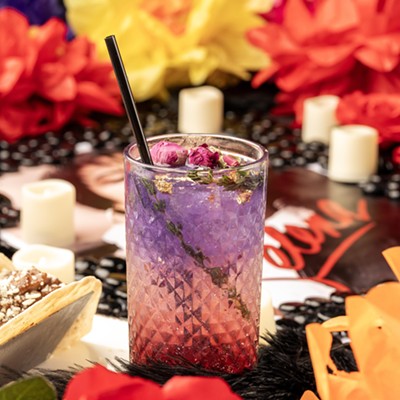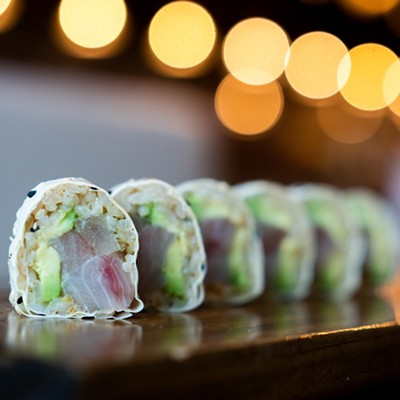There are times when you go to a sushi restaurant knowing exactly what you want to order. You dutifully fill out the sushi menu with two orders of hotate (scallop), maguro (tuna), hamachi (yellowtail) and whatever catches your fancy. Maybe you’re a roll person, and your go-to thing is the spicy tuna roll. Maybe you prefer forgoing the rice completely for a dinner of sashimi. Ordering à la carte is a good way to eat sushi if you want to maintain control. It’s safe, easy, predictable and good for a quick bite to eat.
When you want to have an incredible sushi experience, however, make a reservation for an omakase, which is essentially a chef’s tasting menu of the day’s best items. This is what I do whenever I want to treat myself to a mind-blowing meal, and my go-to spot — the place I found myself on a recent Tuesday evening as I celebrated a belated birthday dinner — was the sushi bar at Kata Robata.
Chef Manabu Horiuchi (“Hori-san”) was the first sushi chef that I trusted when I moved to Houston in the early 2000s. At the time, Miyako and Cafe Japon were in fashion, but I didn’t care for either. I came to know Hori-san when he was executive chef at Kubo’s in Rice Village, the first place in Houston that I frequented regularly for sushi.
In 2009, Hori-san opened Kata Robata. It’s years later, but I still remember my first visit, during lunch. We ordered the omakase at approximately $75 per person. I remember because it was a big splurge for a lunchtime repast, but it was totally worth it. In particular, one of the nigiri sushi he made gave me that When Harry Met Sally food-gasm-type moment. It was a nigiri sushi of whole scallop topped with seared foie gras, which was so delicious I can still conjure up the memory to this day. I was hooked on Hori-san’s omakase from that moment on, and I try to revisit whenever I can.
My most recent omakase started with a Peruvian-style tiradito of thinly sliced snapper topped with uni, and a leche de tigre ("tiger’s milk" marinade of lime and fish) with crushed hazelnut. It was delicate and so light it acted almost like a palate cleanser, setting the stage for our next course, the duck chawanmushi topped with freshly shaved white truffle.
Chawanmushi is a warm Japanese silken egg custard that is somewhat reminiscent of silken tofu. It has a beautifully smooth texture that sort of slides over your palate like a caress. Because its base is a dashi broth (made of konbu and dried bonito flakes), chawanmushi is packed with umami. The duck gives it a bold, earthy meatiness, while the shaved white truffle imparts an aphrodisiacal aroma that stimulates your erogenous zone for food enjoyment. In other words, it’s to die for.
We’d barely come down from the high of the chawanmushi when Hori-san served three slices of glistening pink, marbled, heavenly o-toro (fatty tuna) from Spain, accompanied by freshly grated wasabi.
Next came a sashimi of seared akamutsu, torched à la minute to give the skin a slight smokiness. Extraordinary.
A salmon belly was served next, the bright orange, striated flesh plump and fatty, naturally sweet, and oh so delicious.
From the kitchen, next up was a pan-seared kinmedai (Japanese golden-eye snapper) laid atop four small cubes of seared foie gras. It was good, but I was craving everything from the sushi bar, so I asked Hori-san for more sushi.
He complied. Next up was a piece of ika (squid) and chu-toro (mid-fatty tuna). Both were good, but the chu-toro was divine — smooth, with a luscious quality that lingered on the palate.
Then came one of my all-time favorites — amaebi (sweet shrimp) topped with uni (pictured at top). I’ve ordered this elsewhere, but Kata’s version somehow just tastes better. You will never go wrong if you order this at Kata.
To follow, a trio of nigiri sushi that included that beautiful o-toro we’d tasted in sashimi form, tai (sea bream), and uni. For our last course, Hori-san gave us what he called his own version of steak and eggs, definitely saving the best for last. A5 wagyu from Japan — arguably some of the highest-quality meat in the world — was seared and sliced, and served over scrambled eggs and sweet Japanese cucumber pickles, and finished off with shaved white Alba truffle. Suffice it to say that it was one of those dishes that make you want to lick the plate.
We were too full by the time we finished our last course, opting to skip dessert. That's the beauty of omakase. It's a completely customized experience based on your preferences, pocketbook (you can set the budget if you have one) and whatever the chef has that's extraordinary that day, and you are almost always guaranteed a superlative meal.
Support Us
Houston's independent source of
local news and culture
account
- Welcome,
Insider - Login
- My Account
- My Newsletters
- Contribute
- Contact Us
- Sign out
[
{
"name": "Related Stories / Support Us Combo",
"component": "11591218",
"insertPoint": "4",
"requiredCountToDisplay": "4"
},{
"name": "Air - Billboard - Inline Content",
"component": "11591214",
"insertPoint": "2/3",
"requiredCountToDisplay": "7"
},{
"name": "R1 - Beta - Mobile Only",
"component": "12287027",
"insertPoint": "8",
"requiredCountToDisplay": "8"
},{
"name": "Air - MediumRectangle - Inline Content - Mobile Display Size 2",
"component": "11591215",
"insertPoint": "12",
"requiredCountToDisplay": "12"
},{
"name": "Air - MediumRectangle - Inline Content - Mobile Display Size 2",
"component": "11591215",
"insertPoint": "4th",
"startingPoint": "16",
"requiredCountToDisplay": "12"
}
,{
"name": "RevContent - In Article",
"component": "12527128",
"insertPoint": "3/5",
"requiredCountToDisplay": "5"
}
]
KEEP THE HOUSTON PRESS FREE...
Since we started the Houston Press, it has been defined as the free, independent voice of Houston, and we'd like to keep it that way. With local media under siege, it's more important than ever for us to rally support behind funding our local journalism. You can help by participating in our "I Support" program, allowing us to keep offering readers access to our incisive coverage of local news, food and culture with no paywalls.
Mai Pham is a contributing freelance food writer and food critic for the Houston Press whose adventurous palate has taken her from Argentina to Thailand and everywhere in between -- Peru, Spain, Hong Kong and more -- in pursuit of the most memorable bite. Her work appears in numerous outlets at the local, state and national level, where she is also a luxury travel correspondent for Forbes Travel Guide.
Contact:
Mai Pham
Trending Food & Drink
- This Week in Houston Food Events: Tony's Celebrates 59 Years of Fine Dining
- Openings and Closings: Maximo and Local Foods Open, Magnol Heights Coming
- Where to Dine in Houston This Mother’s Day 2018
-
Sponsored Content From: [%sponsoredBy%]
[%title%]

Don't Miss Out
SIGN UP for the latest
food & drink
news, free stuff and more!
Become a member to support the independent voice of Houston
and help keep the future of the Houston Press FREE
Use of this website constitutes acceptance of our
terms of use,
our cookies policy, and our
privacy policy
The Houston Press may earn a portion of sales from products & services purchased through links on our site from our
affiliate partners.
©2024
Houston Press, LP. All rights reserved.





